Seafood squid ink pasta recipe lovers, this one’s for you. Bold, briny, and unapologetically dramatic, this dish brings the ocean to your plate in the most delicious way. With glossy black noodles wrapped in a rich sauce and studded with tender shrimp or scallops, it tastes like something from a seaside trattoria—but you can easily make it at home. Whether you’re planning a date night or just craving something wildly different, this seafood squid ink pasta recipe delivers both style and substance. In this guide, I’ll walk you through every foolproof step to create a truly unforgettable pasta experience.
Table of Contents
Table of Contents
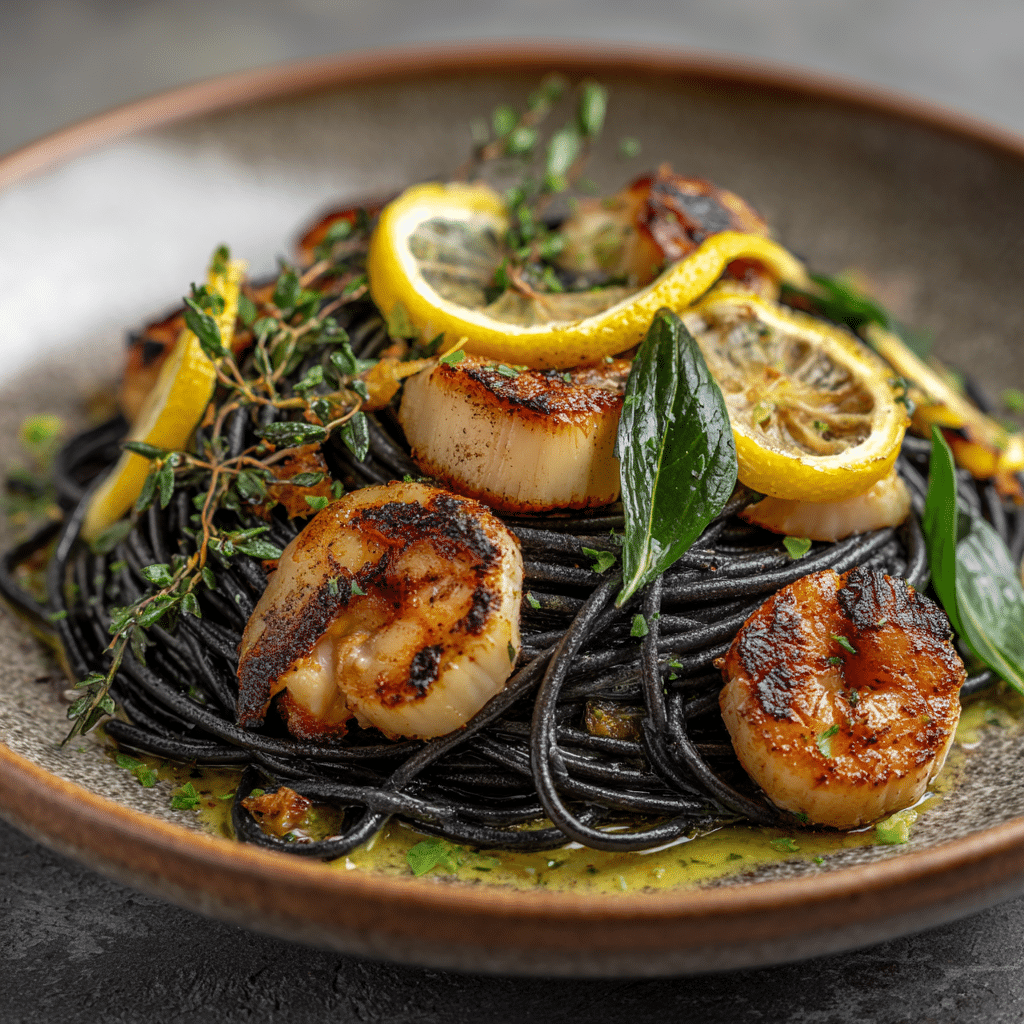
How a Bowl of Seafood Squid Ink Pasta Became My Signature Dish
I still remember the first time I tasted squid ink pasta with seafood. I was sitting on a breezy patio in Cinque Terre, and the plate they placed in front of me was unlike anything I’d seen—glossy black noodles tangled with clams, shrimp, and scallops, glistening in the sunlight. One bite in, I was captivated. The flavor was deep, salty in the best way, and bursting with coastal charm. That moment marked the beginning of my obsession with recreating the perfect seafood squid ink pasta recipe at home.
Back in my cozy North Carolina kitchen, I was determined to make it work without the fuss. I didn’t want a dish that took hours or required a culinary degree. I just wanted to capture that richness, the texture of perfectly cooked seafood, and the thrill of serving something so visually bold. What surprised me most? It was simpler than I expected.
This seafood squid ink pasta recipe became my go-to for dinner parties and date nights. It never fails to impress, not just for the looks—but for the layered flavor that comes together in under 30 minutes. With the right ingredients and a bit of confidence, you can serve a dish that feels five-star without spending hours in the kitchen.
And honestly, the way people’s eyes light up when they see it? That’s half the fun.
If you’re someone who enjoys dramatic, flavor-forward dishes, you’ll also want to try our boursin pasta recipe or add variety to your table with cabbage and carrots done right.
Print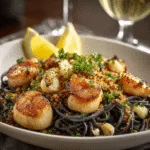
Seafood Squid Ink Pasta Recipe – Bold Flavor, 5-Star Results!
- Total Time: 30 mins
- Yield: 2 servings 1x
Description
This seafood squid ink pasta recipe combines the bold flavor of squid ink with tender shrimp and scallops for a briny, elegant dish that’s easy to make at home.
Ingredients
- 8 oz squid ink pasta
- 2 tsp squid ink (nero di seppia)
- 2 tbsp olive oil
- 3 garlic cloves, minced
- 1 small shallot, finely chopped
- 1/4 cup dry white wine
- 1/2 cup seafood stock or pasta water
- 1/4 tsp red pepper flakes
- 1/2 tsp sea salt (plus more for pasta water)
- Zest of 1 lemon
- 2 tbsp fresh parsley, chopped
- 6 large shrimp, peeled and deveined
- 4 scallops
- Optional: toasted breadcrumbs, lemon wedges
Instructions
- Bring a large pot of salted water to a boil and cook squid ink pasta until al dente. Reserve 1/2 cup pasta water, then drain.
- In a skillet, heat olive oil over medium heat. Add garlic and shallots, sauté for 2–3 minutes until fragrant and soft.
- Add wine and let it reduce by half. Stir in squid ink and seafood stock. Simmer gently until sauce thickens slightly.
- Sear shrimp and scallops in a separate pan until just cooked. Set aside.
- Transfer cooked pasta into the squid ink sauce. Toss with a splash of pasta water until coated.
- Add cooked seafood back to the skillet. Stir in lemon zest and chopped parsley.
- Plate and garnish with extra parsley, lemon wedges, and toasted breadcrumbs if desired. Serve immediately.
Notes
Cook seafood separately to prevent overcooking.
Use fresh seafood and high-quality squid ink for best flavor.
Store leftovers in the fridge for up to 2 days. Reheat gently in a skillet with a splash of water.
- Prep Time: 10 mins
- Cook Time: 20 mins
- Category: Dinner
- Method: Stovetop
- Cuisine: Italian
Nutrition
- Serving Size: 1 bowl
- Calories: 460
- Sugar: 1g
- Sodium: 580mg
- Fat: 15g
- Saturated Fat: 3g
- Unsaturated Fat: 10g
- Trans Fat: 0g
- Carbohydrates: 52g
- Fiber: 3g
- Protein: 28g
- Cholesterol: 110mg
Choosing the Right Seafood for Squid Ink Pasta
The beauty of this seafood squid ink pasta recipe is how customizable it is—especially when it comes to the seafood. The goal is to complement the briny richness of the squid ink without overpowering it. You want seafood that brings texture, sweetness, and freshness to every bite.
Start with shrimp. It’s easy to cook, widely available, and adds a pop of color against the black noodles. Look for large, peeled, and deveined shrimp—wild-caught if possible. Sauté them briefly until just pink and tender.
Next up: scallops. Their buttery, delicate flavor pairs beautifully with the umami of squid ink. A quick sear in a hot pan gives them that golden crust that balances the dish’s boldness. Clams and mussels are also traditional additions, offering a burst of ocean flavor and a bit of interactive fun at the table.
If you want to elevate things further, add calamari rings or baby octopus for variety in texture. Just remember—seafood cooks fast. You’ll want to prepare it separately and fold it in at the end to avoid rubbery bites.
Prefer a pescatarian twist without shellfish? Sliced smoked salmon or even chunks of white fish like cod or halibut work surprisingly well with this squid ink base.
Once you’ve chosen your lineup, keep the rest of the ingredients simple to let the seafood shine. A bit of garlic, wine, and lemon is all you need to build a flavor-packed base.
For more hearty and seafood-friendly recipes, take a look at our crock pot corned beef and potatoes or explore the full cooking style collection.
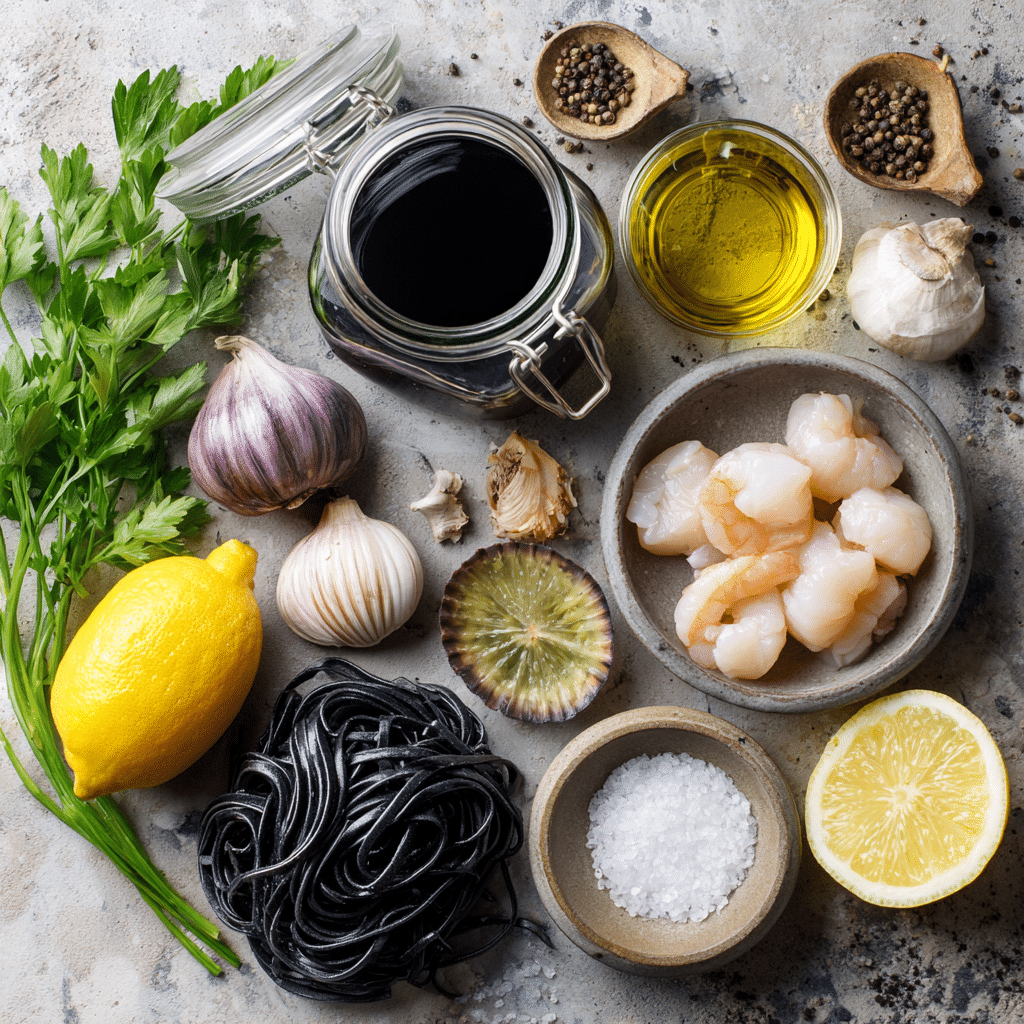
Building the Perfect Squid Ink Sauce
The heart of any great seafood squid ink pasta recipe is the sauce—it’s where all that deep, savory magic happens. While the jet-black color might suggest complexity, the process is surprisingly simple. The key is building layers of flavor using just a handful of quality ingredients.
Start with olive oil, garlic, and shallots. Sauté them gently over medium heat until soft and fragrant. This is your aromatic base and it matters—don’t rush it. Next, pour in a splash of dry white wine. The acidity lifts the sauce and deglazes the pan, picking up all those delicious browned bits.
Now comes the star: squid ink. You only need a small amount—about 1 to 2 teaspoons per serving. Stir it in slowly and watch as the sauce transforms into an inky, glossy masterpiece. Add seafood stock (or reserved pasta water) to adjust consistency. This creates a silky finish that clings beautifully to every strand of pasta.
Season it with salt and a pinch of red pepper flakes for subtle heat. At the very end, a zest of lemon brings brightness and balance. If you’re adding seafood like shrimp or scallops, fold them in gently just before serving so they stay tender.
Don’t overcomplicate this sauce—its strength lies in bold simplicity. Let the squid ink lead, and allow the aromatics and seafood to enhance it naturally.
Love this kind of rich, layered flavor? You’ll also appreciate the smooth indulgence of our boursin pasta recipe or the savory comfort of corned beef in crock pot done right.
Cooking and Assembling Your Seafood Squid Ink Pasta
Now that your sauce is rich, glossy, and layered with flavor, it’s time to pull everything together. This part of the seafood squid ink pasta recipe is all about timing and texture. You want your pasta al dente, your seafood tender, and your sauce silky enough to coat every strand.
Start by bringing a large pot of salted water to a rolling boil. Cook your squid ink pasta just until al dente—firm to the bite but not underdone. Reserve about a half cup of the pasta water before draining. This starchy liquid helps loosen and emulsify your sauce later on.
While the pasta cooks, warm your squid ink sauce gently over low heat. If you’ve cooked your seafood separately, now’s the time to fold it in. Add shrimp, scallops, or clams to the sauce and let them finish heating through. You don’t want them rubbery—just barely firm and juicy.
Transfer the drained pasta straight into the skillet with the sauce and seafood. Toss everything together with tongs, adding a splash of the reserved pasta water to get that luscious, glossy finish. Every strand should be coated, but not swimming.
Taste and adjust the seasoning. A touch more salt, an extra squeeze of lemon, or a final crack of black pepper can elevate everything. Plate in wide, shallow bowls and garnish with chopped parsley or lemon zest for color and contrast.
This step is fast but important—prep everything in advance so you can assemble with ease.
If you enjoy this hands-on, flavor-forward style of cooking, explore our easy meals collection or end your evening with a refreshing treat like frozen yogurt bark.
Presentation Tips and Garnish Ideas
This seafood squid ink pasta recipe doesn’t just taste luxurious—it looks it. The deep black noodles are already visually stunning, so your job is to elevate the presentation with contrast, texture, and a few simple garnishes that make each plate restaurant-worthy.
Start with your plate choice. A shallow white or gray bowl creates a clean canvas that lets the jet-black pasta stand out. Avoid dark plates—they can make the entire dish feel too heavy. Neatly twirl the pasta into a nest using tongs or a carving fork for an elegant look.
Next comes the color contrast. Bright green parsley, lemon zest curls, or even a few thinly sliced scallions add a fresh, vibrant pop. For an extra layer of texture and flair, sprinkle toasted breadcrumbs or drizzle a touch of herb oil across the top.
If you’ve used shrimp or scallops, arrange them intentionally—on top or slightly to the side so they don’t get lost in the sauce. For clams or mussels in shell, cluster them artfully for height and drama.
A few finishing touches go a long way: flaky sea salt, a light dusting of Parmesan (if you’re not strict on seafood-dairy combos), or even a small dollop of lemon crème fraîche for creamy contrast.
Lighting matters too—if you’re sharing this dish on social, aim for natural light or warm ambient tones. It brings out the gloss and richness of the sauce.
Want more creative plating inspiration? Try serving alongside a slice of cinnamon roll focaccia for sweet-savory contrast, or browse our dessert recipes to round out the meal beautifully.
Common Mistakes to Avoid with Seafood Squid Ink Pasta
Making this seafood squid ink pasta recipe might seem intimidating, but most mistakes are easy to avoid once you know what to look out for. Whether you’re cooking it for the first time or fine-tuning your version, steering clear of these pitfalls will ensure every plate turns out restaurant-quality.
Using too much squid ink
A little goes a long way. Adding too much can make the sauce overly briny or even metallic. Stick with about 1–2 teaspoons per serving. The goal is a balanced, umami-rich flavor—not something that tastes like ocean water.
Overcooking the seafood
This is one of the most common slip-ups. Shrimp, scallops, and squid cook quickly, so it’s best to sear or steam them separately and fold them into the sauce just before serving. Overcooked seafood becomes chewy and dull, which undercuts the elegance of the dish.
Undersalting the pasta water
Since squid ink has natural salinity, many cooks skip seasoning the water—but this leads to bland pasta. Salt your pasta water generously; it’s the first layer of seasoning your dish needs.
Skipping acidity
Without a touch of lemon juice or zest, the dish can feel flat. Acidity brightens the deep flavors and gives the entire recipe a fresh finish.
Rushing the aromatics
Garlic and shallots form the flavor base. Sauté them gently—burning or undercooking them creates bitterness or lack of depth.
For more flavor-focused guidance, check out our rich and satisfying pink salt diet recipe or slow-simmered slow cooker corned beef.
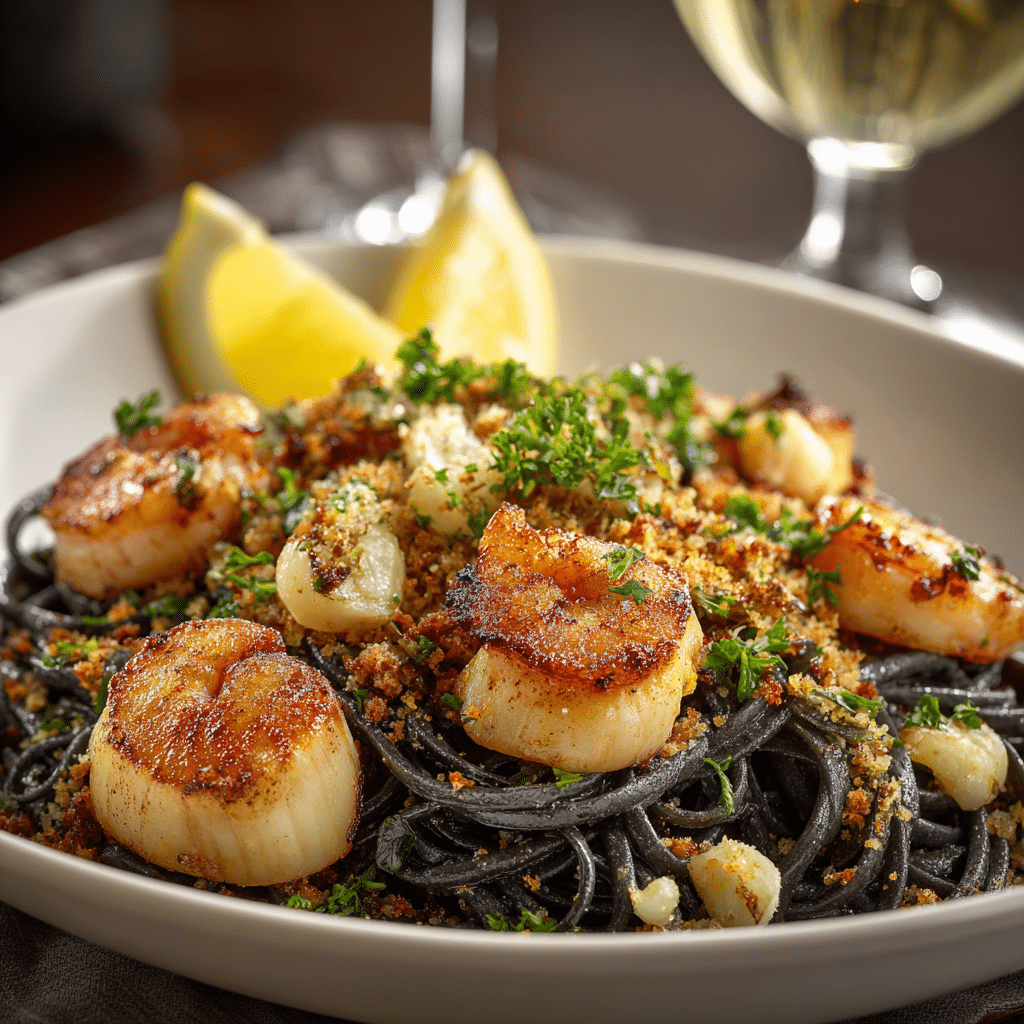
How to Store and Reheat Squid Ink Pasta with Seafood
If you’re lucky enough to have leftovers from your seafood squid ink pasta recipe, storing and reheating them properly makes all the difference. Done right, the bold flavor and silky texture can still shine the next day.
Storing the Pasta and Seafood Separately
The first tip? Keep the pasta and seafood components separate if possible. While the noodles can hold up well in the fridge, seafood tends to become rubbery if reheated too long. Store your pasta in an airtight container and refrigerate for up to two days. Place any shrimp, scallops, or shellfish in a separate container with a spoonful of sauce to keep them moist.
Reheating for the Best Results
Skip the microwave if you can. Instead, warm the pasta in a skillet over low heat with a splash of water or seafood stock. Stir gently to revive the sauce without drying it out. If your seafood is already cooked, warm it separately—just enough to heat through—then combine just before serving.
For dishes like this, reheating is all about gentle heat. That’s what keeps the noodles soft, the sauce glossy, and the seafood tender.
Refreshing the Flavor
Before serving, brighten things back up with a fresh sprinkle of lemon zest or a handful of chopped parsley. It’ll bring back the vibrancy and balance after refrigeration.
Love recipes that store and reheat beautifully? Try our ultra-comforting corned beef in crock pot recipe or explore more practical ideas in the easy meals section.
Final Thoughts on Making the Best Seafood Squid Ink Pasta
There’s something unforgettable about this seafood squid ink pasta recipe—from the bold color to the ocean-kissed flavor, every element works together to create a dish that’s both beautiful and deeply satisfying. It’s the kind of recipe that turns an ordinary evening into something memorable.
What makes it so special isn’t just the squid ink—it’s the way everything comes together. Fresh seafood brings sweetness and texture. The glossy black sauce, built on simple aromatics and a splash of wine, delivers depth without complexity. And the final touches—lemon zest, parsley, maybe a touch of Parmesan—take it to another level entirely.
Once you’ve tried this recipe, it’s easy to make it your own. Change up the seafood, play with spice, or even pair it with a side of roasted vegetables or garlic bread. It’s versatile, elegant, and easier than it looks—which is why it’s become a staple in my kitchen.
So the next time you want to impress someone—or just treat yourself—don’t hesitate. Grab a jar of squid ink, your favorite pasta, and some fresh seafood, and bring the coast to your table.
Want more recipes that balance elegance and ease? Check out this indulgent boursin pasta recipe or for something sweet and surprising, try our cinnamon roll focaccia. Both offer the same wow-factor with none of the stress.
Because great food doesn’t have to be complicated—it just has to be made with heart.
FAQ about seafood squid ink pasta recipe
1. What seafood goes best with squid ink pasta?
Shrimp, scallops, mussels, clams, and calamari all pair beautifully with squid ink pasta. Their sweetness and tender texture balance the briny flavor of the squid ink sauce. You can also use a seafood mix for added variety, but make sure to cook each type properly to avoid overcooking.
2. Is squid ink pasta safe to eat?
Yes, squid ink is completely safe to eat and widely used in Mediterranean cuisine. It adds a rich umami flavor without overpowering the dish. Just make sure you’re using food-grade squid ink from a reputable brand, typically labeled as “nero di seppia.”
3. Can I make seafood squid ink pasta ahead of time?
You can prep the components ahead—cook the sauce, clean the seafood, and measure the pasta. But for best results, cook and combine everything just before serving. Reheating works well if you store seafood and pasta separately and warm them gently.
4. What wine pairs well with seafood squid ink pasta?
Dry white wines like Pinot Grigio, Vermentino, or Sauvignon Blanc work best. They cut through the richness of the squid ink and enhance the seafood. For a festive touch, sparkling wines like Prosecco also pair beautifully with this dish.

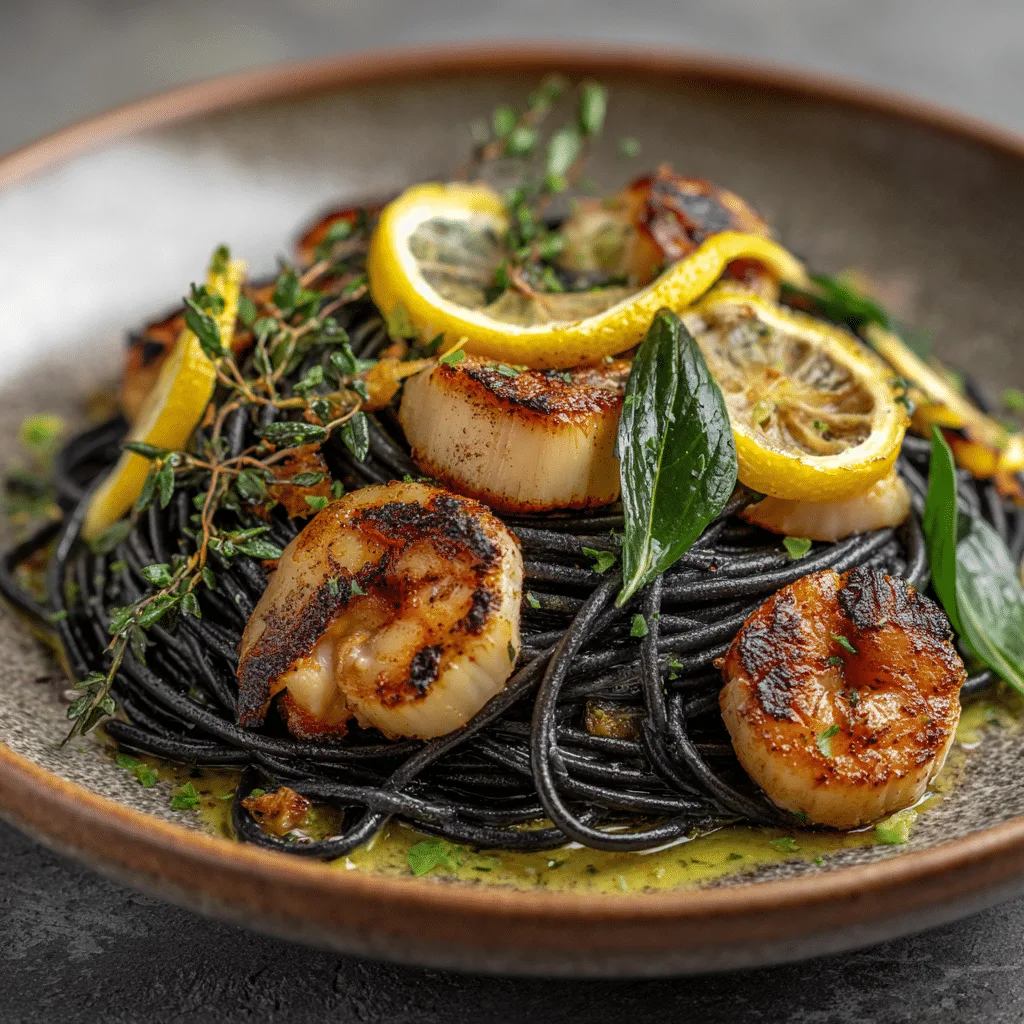
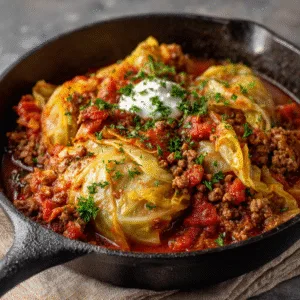
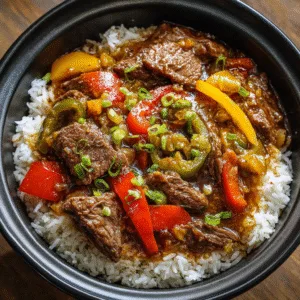
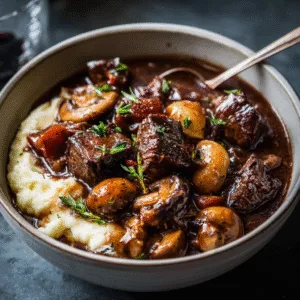
1 thought on “Seafood Squid Ink Pasta Recipe – Bold Flavor, 5-Star Results!”